Gardening in the central Plains can be both tricky and quite easy. We’re faced with two realities: wind and annual temperatures ranging from around -40 to 110 degrees Fahrenheit. Plants have to be able to bend and not break, and so do our gardens and our expectations for them. What I mean by the latter point is that by their very nature, plants native to the central Plains are adapted to give in early in a bad year and outperform all dreamy expectations in a good year — we just never know which kind of year it will be. Native plants may flower less one year, and top growth may even be killed off in a drought. We should be OK with this event in our gardens, appreciating the intelligence and survival of flowers and grasses so well evolved for open grasslands.
My top-10 list is focused exclusively on wildflowers. Why? It’s not because we don’t have lovely native shrubs or trees, like the bur oak (
Quercus macrocarpa), but because blooming herbaceous perennials support a key group of wildlife: insects. These remarkable creatures ensure plant reproduction and genetic plant variability to withstand climate swings, help develop seeds that feed countless wildlife, provide untold amounts of free pollination services on farms and themselves feed all manner of grassland and songbirds.
The best time to plant wildflowers? Midspring to early summer, and especially early to midfall (my favorite gardening period). Most seeds need cold, moist stratification, so it’s best to seed them on bare soil — or snow — in late fall to midwinter. Just make sure you plant your natives in the right place, which will guarantee a truly low-maintenance garden.
Not in the central Plains? Browse plants native to more regions of the U.S.
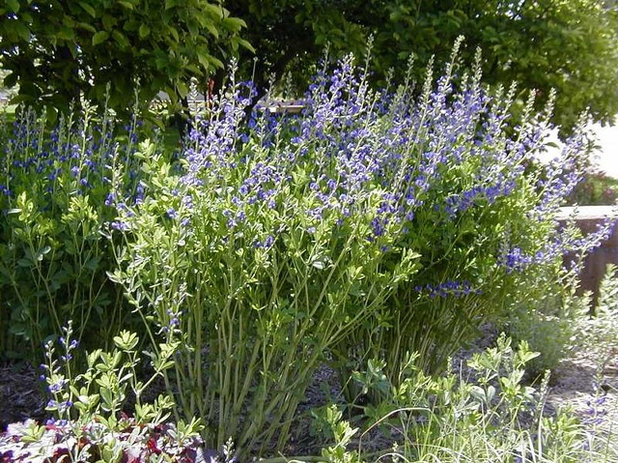
Missouri Botanical Garden
Blue Wild Indigo(
Baptisia australis)
Native to a very small range from eastern Nebraska into most of Kansas and Oklahoma
I hear you saying, “I’ve got this dry, nasty, sunny spot where nothing grows — I just need something with some stature to work there.” Gotcha. At 3 to 4 feet tall and wide, this herbaceous perennial comes back every year to the size of a small shrub. The drier the soil, the better, but because it has a long taproot, you shouldn’t plan on moving it once it’s established.
In May the blooms are covered with hungry queen bees starting their new colonies, and some sulphur butterflies lay eggs on it. Unique, soft blue leaves make it interesting after bloom, as do the black rattling seedpods in fall. There are lots of bred cultivars out there now, but try to stick with the species to ensure best wildlife value.
See how to grow blue wild indigo
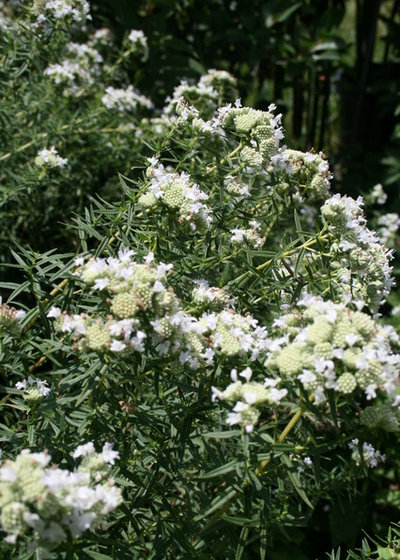
Benjamin Vogt / Monarch Gardens
Virginia Mountain Mint(
Pycnanthemum virginianum)
Native from the eastern Dakotas south through Nebraska and eastern Kansas and Oklahoma, stretching eastward into the tallgrass region
This is a well-behaved clumping mint that spreads more slowly than chunky peanut butter, and I’ve rarely seen a greater diversity of insects than on this one plant. Long blooming, from June into August, it has leaves that are highly aromatic and great in food. At no more than 2 feet tall and perhaps 2 feet wide after several years, it can be placed anywhere in full sun, from moist to slightly dry soils. It’s certainly a plant that should be used far more often in our gardens.
See how to grow Virginia mountain mint
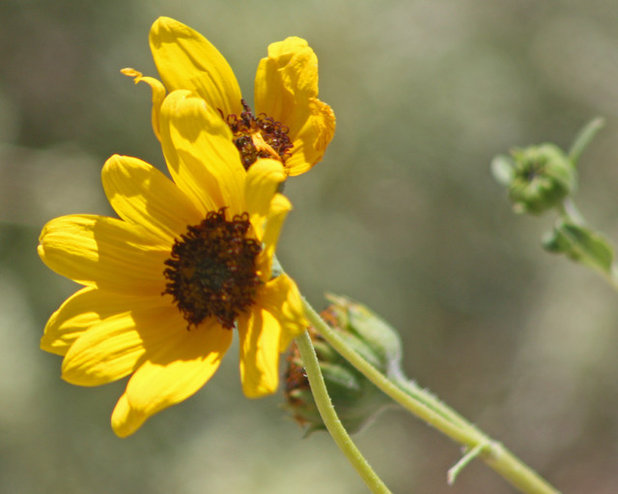 Prairie Sunflower
Prairie Sunflower(
Helianthus petiolaris)
Native across almost the entire Great Plains region and upper Midwest
If you’ve got a large, open area, you really should have sunflowers. In some years annual sunflowers, like
H. petiolaris, will dominate an area, usually after a disturbance like a fire, until other plants fill in. Prairie sunflower, also called plains sunflower, grows about 2 to 3 feet tall and wide; prefers dry to even, sandy soil in full sun; and will have more than 30 blooms, each about 2 to 3 inches across, all summer into fall.
In general, sunflowers provide nectar for a multitude of insects, who get it both from the flower and along the stem, while the seeds support all kinds of birds and mammals for many months. They’re one-stop convenience stores.
See how to grow prairie sunflower
Photo by the National Park Service
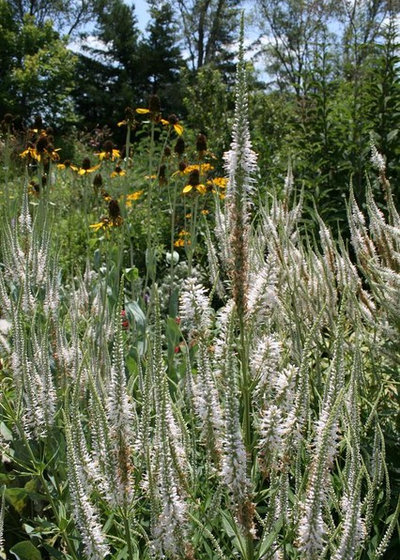
Benjamin Vogt / Monarch Gardens
Culver’s Root(
Veronicastrum virginicum)
Native along the eastern edges of the Dakotas through Oklahoma, and most points east from there
Looking for something really cool and unexpected? Culver’s root has one of the most unique flowering shapes, whose ornamental value lasts through winter. You’re sure to see many interesting pollinators while it’s blooming in the high heat of summer — it’s just humming with life.
Place it in full sun to partial shade in moist to medium soil, from clay to loam, and you’ll be the envy of bees and plant collectors. It grows 3 to 5 feet tall and about 2 feet wide.
See how to grow Culver’s root
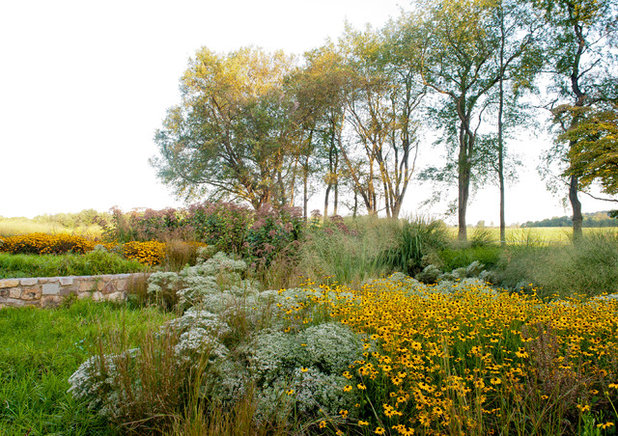
jonathan alderson landscape architects, inc.
Common Boneset(
Eupatorium perfoliatum)
Native from Minnesota to Nebraska, south to eastern Texas and the eastern U.S.
It’s got hairy leaves. It’ll bring flies, bees, butterflies, moths and so much more. It blooms in midsummer. Just look at it in this image — the soft swaths of undulating, puffy white blooms. Preferring consistently moist to wet soils, boneset will reach 3 to 4 feet tall and about 2 feet wide. Full sun is best, but it can take some shade for half the day. Lots of moth species use it as a host plant, and most mammals don’t like eating it. A winner.
See how to grow boneset
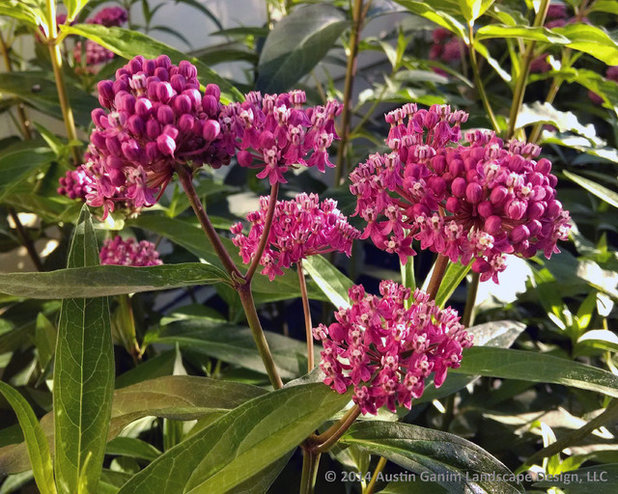
Austin Ganim Landscape Design, LLC
Swamp Milkweed(
Asclepias incarnata)
Draw a rectangle for its native range — the western edge from the Dakotas south to Oklahoma and all the way east to the Atlantic
It’s hard to pick just one milkweed, because many of the 140-plus species in North America offer something spectacular when planted in the right place. However, for me, swamp milkweed attracts the most insects who use it as a host plant, from monarchs to milkweed beetles and bugs to tussock moths.
Contrary to its common name, swamp milkweed, also called red milkweed, can do fine in a medium to slightly dry soil once established — consistent moisture in full sun is best, but partial shade works, too. Try other species, like butterfly milkweed (
A. tuberosa), rare Sullivant’s (
A. sullivanttii) and the prettiest-blooming purple milkweed (
A. purpurascens).
See how to grow swamp milkweed
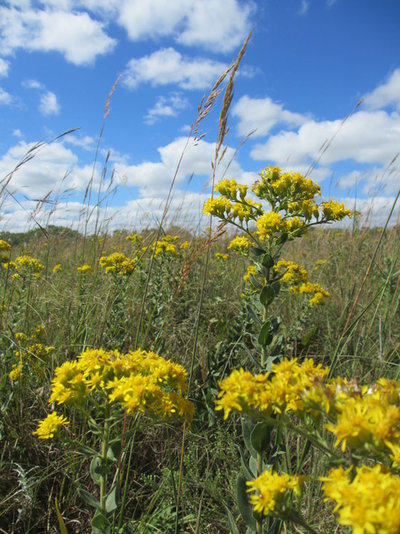
Benjamin Vogt / Monarch Gardens
Stiff Goldenrod(
Solidago rigida)
At home in the Rocky Mountains region, most of the Great Plains and upper Midwest
Really, you can pick any goldenrod and know you’re doing right by wildlife and pollinators. I chose stiff goldenrod because of the unique flat-top appearance and its drought tolerance. In the wild it’s a bit shorter, at 2 to 3 feet tall, whereas in the home garden it can reach 4 feet tall. Full sun is best to keep it from leaning toward the light, and the small footprint of 1 foot to 2 feet wide and several stalks after a few years mean you can put it almost anywhere in a garden design. Monarchs seem to especially like this late-summer bloomer as they begin migrating south.
See how to grow stiff goldenrod
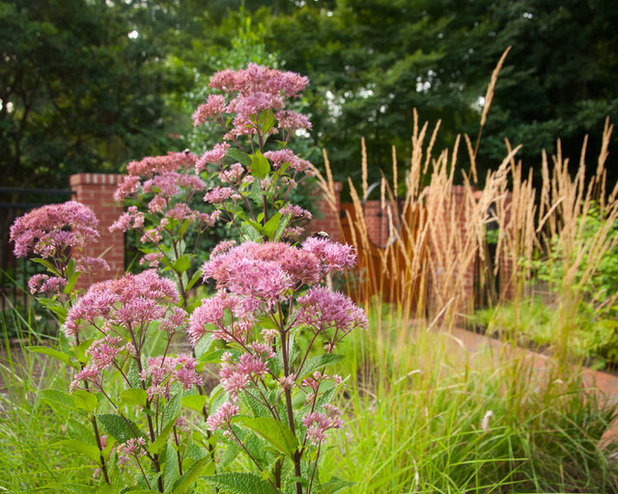
groundworks studio
Spotted Joe Pye Weed(
Eupatorium maculatum)
Native to parts of the Rocky Mountains, into South Dakota and Nebraska, the northern Midwest and New England
Try this Joe Pye Weed if you’ve got a larger area with damp to even mucky soil and you want something tall. This 5- to 7-foot-tall plant has rosy flower umbels high off the ground where butterflies can safely perch from mid to late summer. Moist soil and full sun are best, though a medium soil could work too. The hollow and spotted stalks stand up to wind and provide homes for native bees.
See how to grow spotted Joe Pye Weed
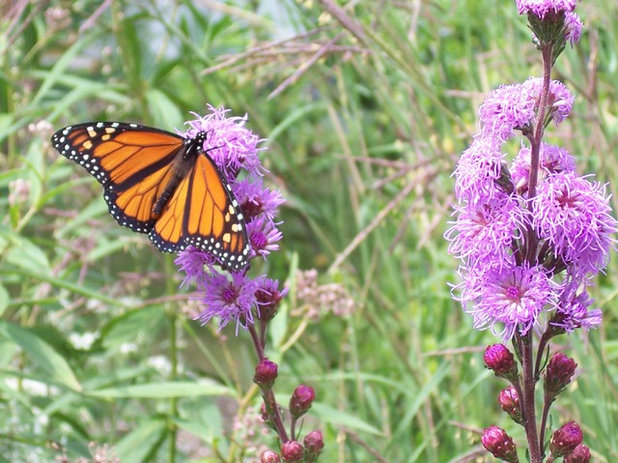 Tall Blazingstar
Tall Blazingstar(
Liatris aspera)
Native from North Dakota down to eastern Texas, east to Wisconsin, Illinois and Louisiana
With such a large native range, your
Liatris aspera could bloom anytime from July (far north) to October (far south). It thrives in poor, dry soils in full sun to partial shade, reaching 3 feet tall and 6 to 12 inches wide. At maturity this plant should have several upright blooming stalks filled with all kinds of bees, butterflies and moths. You can plug it in anywhere, since it has such a narrow footprint — among short grasses or other small perennials. It will also be more unique than the common
Liatris pycnostachya and
L. spicata for sale in most nurseries.
See how to grow tall blazingstar
Photo by Scott Costello
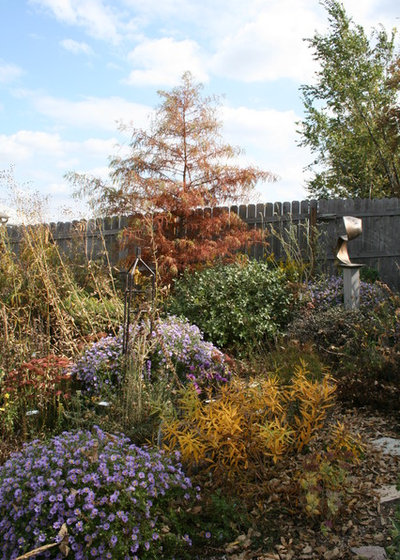
Benjamin Vogt / Monarch Gardens
Aromatic Aster(
Symphyotrichum oblongifolium)
Native from the northern to southern Plains, North Dakota to Wisconsin and south to Arkansas and Texas
This is one of the last, if not the last, asters to bloom each fall — sometimes into early November. Aromatic aster forms a small, shrubby shape about 12 to 18 inches tall and 2 to 3 feet in diameter. Its two best attributes? High drought tolerance, and it’s a superb final pitstop for migrating and overwintering insects. Plus, its bluish-purple blooms laugh at frosts — even a few freezes don’t seem to phase it.
Perfect in drifts, as specimens or used in place of small shrubs. I’ve also seen many a bird and rabbit hiding inside aromatic aster on a snowy winter’s day. It will thrive in full sun, in rocky to gravelly soil to well-drained clay. Plant it and forget it — seriously.
See how to grow aromatic aster





